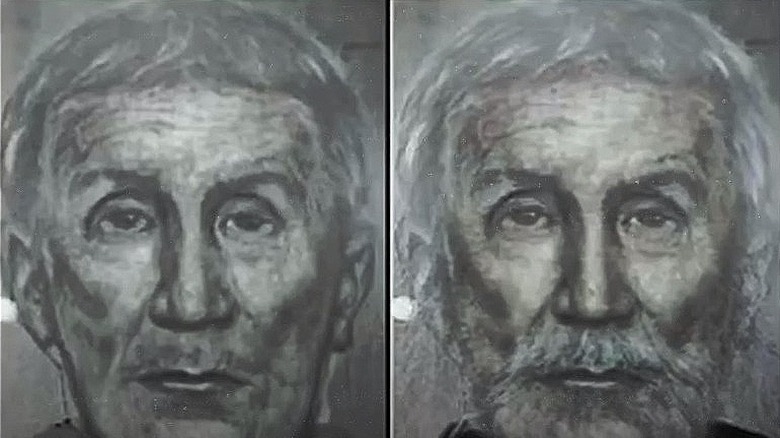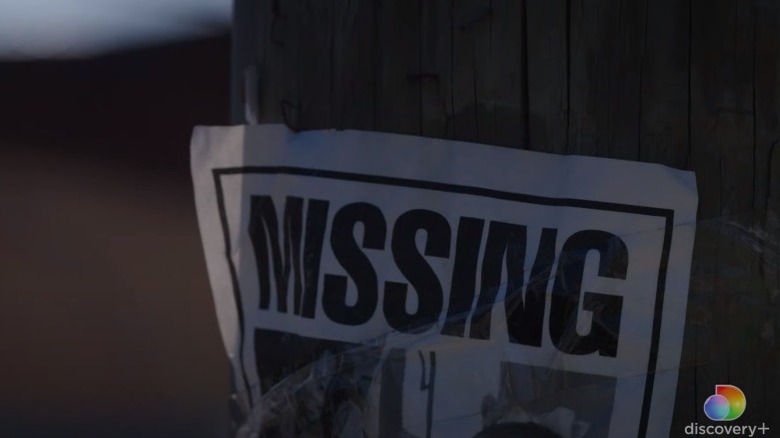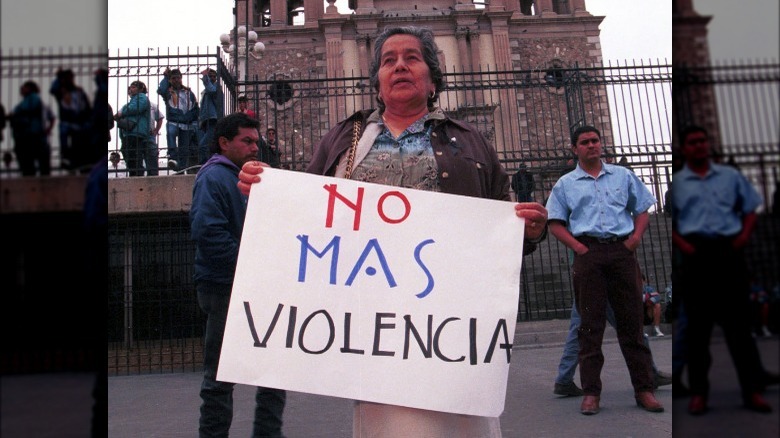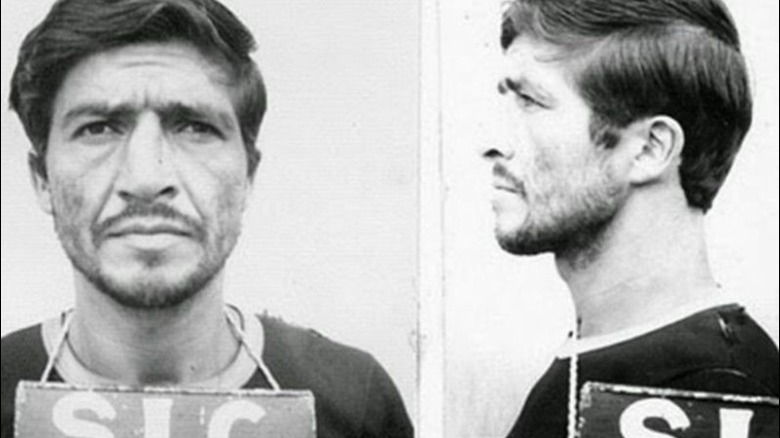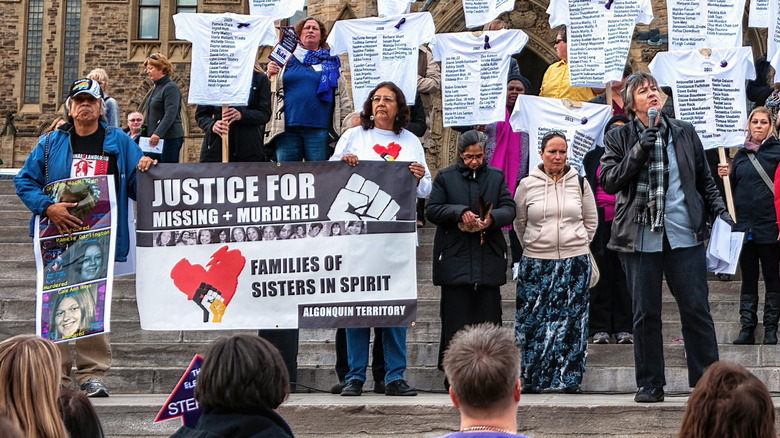The Most Dangerous Active Serial Killers In 2025
So, here's some good news for anyone who suffers from regular nightmares that involve being stalked by a serial killer: They're on the decline. In fact, there are fewer serial killers on the prowl since the dawn of the new century. The 1980s were something of a high point for serial killers, with almost 770 — that we know of — operating across the U.S. during the decade, including some of the worst serial killers in American history. That dropped in the 1990s and again in the 2000s, and by 2016, there had been only about 100 that had cropped up in the prior decade.
There are a few theories that experts have put forward to explain just what's going on here, and they involve things like advances in investigative methods and forensic science, a higher chance of getting caught — and being linked definitively to more crimes — and stricter sentencing. There are also factors like cell phones and an increased connectivity between parents and children that make picking out victims a little more difficult these days. It's also possible that young kids and teens who have the potential to grow up to become serial killers are instead getting the help they need first, so that's all good news.
However, as of 2025, there are still a few serial killers who vanished and were never found out there. In addition to some that have managed to elude capture for a long time, there are a handful of new ones cropping up, too.
The following article includes allegations and descriptions of sexual assault and hate crimes.
I-70 killer
Between April 8 and May 7, 1992, six people were shot and killed along a stretch of I-70. The deaths occurred between Terre Haute, Indiana, and Wichita, Kansas, and there were striking similarities between the victims. Five were women (and police believe that the sixth was mistaken for a woman when the killer saw his long ponytail), all were brunettes, and all were employees at stores just off the highway.
They were also all killed with a .22 caliber bullet. There was no sexual assault and no major thefts, and witnesses were able to give police a basic description of a man seen entering the stores before the murders. He was described as white, with reddish or light brown hair, between 140 and 160 pounds, and around 5 feet 7 inches tall.
The spring of 2022 marked the 30-year anniversary of the still-unsolved murders, and police wanted to make it clear that the case is still very much open. In late 2021, law enforcement released a new sketch of the killer, based on witness accounts and aged to depict what the killer would look like three decades on, and there's still hope that someone will come forward with more information. They've also released what they believe might be the key to catching him: a description of the gun. Wichita police Detective Tim Relph says (via CBS KWCH12) it's "a historic remake of an old German Navy pistol. The barrel is long enough where the gun has a wooden forearm."
Eastbound Strangler
On November 20, 2006, two women who were out for a walk made a grisly discovery: The bodies of four women had been neatly discarded behind the Golden Key Motel in a suburb outside of Atlantic City. The women were fully clothed (except for their shoes and socks) and had been positioned, face-down, in a line behind the motel. Barbara Breidor, Molly Jean Dilts, Kim Raffo, and Tracy Ann Roberts had all been strangled, earning their unidentified killer the nickname of the Eastbound Strangler. Whatever happened had happened quickly. Breidor had been missing for about a month before the bodies were discovered, while Raffo had been seen the day before she was found.
Law enforcement said that at the time, there was definitely no shortage of suspects. One by one, however, they were cleared of the murders until ultimately, there were no more. An appeal for information on the four murders was reissued in the last days of 2021, with Chief of County Investigations Bruce Shields saying (via the Toronto Sun), "Fifteen years later we have not made an arrest for these homicides, but we're always looking, we're always working and reexamining information about this case. We haven't stopped. We won't stop."
A $25,000 reward has been issued for information leading to the killer's arrest, which can be shared with any local law enforcement bodies.
West Mesa Murders
On February 2, 2009, a woman who was out for a walk in Albuquerque came across a human bone, and it ended up being part of a crime scene on a scale that no one could have imagined. All the victims of the so-called "West Mesa Bone Collector" weren't identified for another 11 years. Ultimately, 11 women and one unborn child were found and identified. Their life stories were varied: While many had connections to the drug and sex trades, others did not. Syllannia Edwards was just 15 years old when she disappeared, and it was 22-year-old Michelle Valdez who was pregnant when she was killed and buried in the New Mexico desert.
Although hundreds of people were interviewed and suspects were investigated, the identity of the West Mesa Bone Collector remains one of the many unsolved serial killer mysteries. The investigation is ongoing, and there is a $100,000 reward being offered for information about the killer.
The Long Island Serial Killer
It was late in 2010 that four bodies were recovered from a desolate stretch of beach on the coast of Long Island. It wasn't until the next spring that law enforcement recovered six more bodies and went public with a statement announcing that the murders were all the work of a single killer.
The so-called Long Island Serial Killer case remained a dead end, and some placed the blame squarely on the shoulders of the Suffolk County Police Department. Reports and rumors of corruption have come up amid the department's failure to bring the killer to justice, with some suggesting that it went unsolved because higher-ups in the police department didn't want the truth to come to light.
In late 2021 — near the anniversary of the discovery of the remains of one of the victims, Shannan Gilbert — ABC and Eyewitness News sat down with Ray Tierney, the new district attorney for Suffolk County. He made it clear that he was not only keeping the case open but that he would be re-conducting interviews and reexamining evidence — including claims of corruption.
In July 2023, a man matching the profile put together more than a decade earlier was arrested and eventually charged with seven of the murders. Rex Heuermann's DNA was also found on one of the bodies, along with incriminating internet search history related to the murders. He has pleaded not guilty and as of March 2025, his case is moving to trial.
The Chicago Strangler
Back in 2019, Chicago police were assigning a designated task force to investigate the theory that there was a serial killer stalking the city. For many, it was an investigation that was long overdue. It came more than a year after the Chicago Tribune had run a story that connected the deaths of at least 75 women who had been killed — all via suffocation or strangulation — between 2001 and 2017. The Tribune's initial story ran in 2018, and even as law enforcement balked at the idea of a serial killer, four more women turned up dead in the same manner.
At the time, police were still refusing to say that there was a serial killer at work in Chicago, but did ultimately admit that was a distinct possibility. While they claimed there was little concrete evidence to link the victims, the Tribune reported that others had seen a very clear link: Most of the victims were Black women.
Fast forward to late 2021, and that's when a three-part docuseries called "The Hunt for the Chicago Strangler" started streaming on Discovery+. At the time of the show's debut, Chicago police were still saying nothing to confirm or deny the existence of a serial killer, and at the same time, PBS says activists were demanding answers. Director Jennifer Anderson told them, "I think these women are not just a name on a spreadsheet or police file, they had real lives and we're missing something, because they are not here. They deserve justice..."
Hercules
The three men killed in sub-districts of Bangladesh were identified as Sajal, Ripon, and Rakib Molla. Each had been shot in the head and dumped with a note tied around his neck. The exact messages varied, but the gist was the same: They had been accused of rape, and they were killed for it.
Mahmud Hasan was one of the first on the scene when a body was discovered on January 26, 2019, and later said, "...strangest was the note that hung around his neck. It felt strange and scary to see this happen in my area ... but it also felt like justice." It was the note around Rakib Molla's neck that was signed, and it read: "I am Rakib who raped [victim's name]. This is the fate of the rapist. Rapists be aware ... Hercules." Some called "Hercules" a serial killer, while others called him a vigilante. The difference? That's kind of difficult to define.
Law enforcement said that they were investigating, but at the time, they had no idea if it was one killer or a group of vigilantes acting under a single name. Families of the victims had another theory, stating that witnesses claimed they had been picked up by plain-clothes police almost immediately before turning up dead. Police had ruled out that theory and suggested someone was acting in response to an already-high number of rape cases that were only increasing.
Juarez, Mexico
The bottom line is that no one really knows who is killing the women of Juarez, Mexico. Law enforcement has said there's a likelihood that there's a serial killer prowling the streets of this city just a stone's throw from El Paso, Texas, and they've also suggested the numerous women who have died in recent years were targeted because of gang activity. What's the truth? Everyone would like to know.
Starting in the mid-1990s, hundreds of women began turning up dead. Many were dumped in the desert, many bore signs of trauma and abuse, and it didn't stop: In 2019, there were 1,006 victims added to a list — and those are just the ones law enforcement knows about. The crimes fall under the umbrella of femicide: Whether the victims were targeted by a serial killer who preys on women or by an abusive partner, they were killed because they were women.
In 2020, the high-profile murder of an artist named Isabel Cabanillas de la Torre catapulted Juarez's problems back into headlines. Scores of women took to the streets to protest and demand justice for Cabanillas and the hundreds of other women who have been murdered by killers who have never been identified, much less brought to justice.
Pedro Lopez
Every so often, there's a story that pops up that's so unbelievable, so terrible, that it's impossible to think that it's true. That's definitely the case with Pedro Lopez, but the story of the man dubbed "The Monster of the Andes" is definitely true, because no one could make up something so unimaginable.
After being kicked out of his home as a child — he had assaulted his sister — Pedro Lopez grew up on the streets of Colombia. He traveled across South America, raping and killing as he drifted from one country to another. Nearly executed for his crimes in 1978, he was given a second chance by a missionary who put in a good word for him, but unknowingly kept him alive to keep preying on more victims. It's unknown just how many people he killed, but the numbers are staggering. He confessed to killing as many as two or three people a week, and in 1980, his estimated death toll in Ecuador alone was around 110.
That's where he was arrested and given a 14-year jail sentence. After serving some time there — he had a shortened sentence for "good behavior" — he was sent back to Colombia. There, he was reportedly held in a psychiatric facility for a further four years, then in 1998, he was deemed sane, released on a $50 bond, and promptly vanished. He hasn't been seen since and his victim count is unknown, but the Monster of the Andes could have killed more than 300 people.
The Killing Fields, Texas
Heide Villareal Fye went missing in 1983, and her remains turned up a few months later in an area of Texas now ominously known as The Killing Fields. A little less than two years later, the remains of 16-year-old Laura Miller were found not far from where Fye had been left, and during that investigation, a third body was found. She was known as Jane Doe until she was finally identified in 2019: Her name was Audrey Lee Cook. A fourth body — discovered in 1991 and known as Janet Doe until she, too, was identified in 2019 — was Donna Gonsoulin Prudhomme. There are no known connections between the victims, and no witnesses have come forward to shed light on what happened to the women in their last moments.
There've been plenty of suspects and even some false confessions, but the investigation had stalled completely between the discovery of the fourth victim and the discovery of their identities, while four families have spent years wanting to know what happened in those Texas fields.
With the identification of the final two victims, law enforcement has once again issued an appeal to the public, with FBI Special Agent Richard Rennison saying: "Anything anyone in the public knows, no matter how small they think it is, we really want them to come forward, because it may be very significant to us."
The suspected serial killers of Indigenous Americans
Law enforcement agencies have a ton of resources at their disposal, including the Murder Accountability Project (MAP). Created by investigative journalist Thomas K. Hargrove, it's essentially a database that collects information from various law enforcement agencies and compiles it into a massive file on murders. Algorithms designed to find patterns in the data suggest there are multiple serial killers stalking the Indigenous women of the Americas.
Western University criminologist and MAP board of director member Michael Arntfield shared a pretty dire interpretation of the data he found recorded in the criminal database. He suggested patterns that lit up both the Atlantic and Pacific coasts along with a series of truck stops indicating that serial killers are hunting along the highways. Many of them are truck drivers, Arntfield says (via APTN): "The Highway Serial Killer Initiative has about 400 to 450 offender profiles of unidentified subjects on its database alone that are involved in the trucking industry for the entire Interstate system."
Unfortunately, complete data only exists for the U.S., and a picture of Canada's serial killer landscape remains incomplete. There is, however, some good news: With the discovery that serial killers often doubled as long-haul truckers, the industry created Truckers Against Trafficking training programs that teach drivers to recognize signs of human trafficking. The programs have saved hundreds of lives, but there's still a lot of work to do, as evidenced by the 2025 discovery of the remains of two more Indigenous female victims in Manitoba, Canada.
The Manchester Pusher
In 2015, Birmingham University's professor Craig Jackson started asking questions about the strangely high number of bodies fished out of Manchester's canals, and suggested someone was responsible for them. That escalated into a television documentary, and for many people who had lost loved ones, the idea that they may have actually been the victim of a serial killer — instead of dying by suicide, as most were officially ruled — was a terrifying prospect. What kind of numbers were they talking about? Between 2007 and 2015, 85 bodies were recovered from city waterways. The official line is that 44 of the 72 men were examined with "clear findings" as to the cause of death, and law enforcement also points out that no survivors of any attacks have come forward.
The Greater Manchester Police has stated (via the Manchester Evening News) that there definitely is not a serial killer stalking the streets. Still, in 2022, the case was still very much on the minds of residents — and the "Manchester Pusher" case was examined in a new documentary addressing both the claims of a serial killer on the loose and the claims that it's a myth.
The Jeff Davis 8
Contrary to many serial killings, where the victims of serial killers are connected by similarities, it's the differences between the eight women killed in Louisiana's Jefferson Davis Parish that stand out. The first body was discovered in May 2005, and they ranged in age from 17 to 30, varied in race, were found in different circumstances, and were killed in different ways.
There were still similarities, as all eight women were local to the area, knew each other, and had criminal records. They were all involved in sex work and relaying information about the area's drug trade to law enforcement.
When local law enforcement kept coming up empty and bodies kept dropping, Ethan Brown went to investigate. He says (via Rolling Stone) that he got a taste of what was wrong when he showed up at the murder scene of local dealer David Deshotel only to find people coming, going, and helping themselves to some souvenirs along the way. Brown set up shop to investigate and claimed he turned up not incompetence, but misconduct. When more bodies turned up during his investigation and he connected them with evidence given in the earlier murder cases, he claimed that something was, indeed, rotten in Louisiana. The cases remain unsolved.
The Rainbow Maniac
São Paulo, Brazil, hosts one of the largest gay pride events in the world, and it's phenomenal. In 2008, the city saw somewhere around 3.5 million people flooding the streets to celebrate, but just a few months after that vivid, colorful display of pride, the city was shocked by a series of murders targeting gay men.
There were 13 confirmed victims of the serial killer stalking São Paulo's streets, although there were several more victims that were possibly connected. Starting with the death of 32-year-old Jose Cicero Henrique, they were said to be casualties of the killer dubbed the Rainbow Maniac, with law enforcement saying that he saw himself as responsible for killing men he didn't believe deserved the continued gift of life.
Someone was arrested in connection with the murders, and at a glance, it seemed like there was a pretty good case against them. Witnesses had come forward to claim they had seen a retired police officer named Jairo Francisco Franco shoot and kill one of the men found dead in São Paulo's Paturis Park. Franco went to trial for the murders, but he was found not guilty by the jury and was immediately released. The killer has never been satisfactorily identified, and meanwhile, violence against Brazil's LGBTQ+ community continues to rise.
The Danilovsky Maniac
Piecing together what's going on deep in Russian territory is always a bit of a challenge, and that's the case with the serial killer dubbed the Danilovsky Maniac. The killer claimed the lives of a series of victims between 2004 and 2007, and was given his nickname after the remains of one woman were discovered on Cherepovets' Danilov Street.
Victims were described as having been killed in horrible ways: One woman was stabbed multiple times, while another had her liver removed. Another victim was found stuffed in a water-filled sewer.
And here's the shocking thing: Law enforcement knows quite a lot about the Danilovsky Maniac. In addition to having a fairly good description of him — heavyset, dark blond, with patchy hair, gray eyes, and somewhere between 35 and 40 years old — there were also multiple witnesses who saw someone tagging walls with the X-rated graffiti that showed up around each killing. Perhaps even more shocking is that material recovered from beneath the fingernails of the victims has allowed for the reconstruction of the killer's DNA. With nothing to match it against, that killer has gone unidentified.
Antonio Angles
The most famous victims connected to suspected serial killer Antonio Angles died in 1992, when Antonia Gomez, Miriam Garcia, and Desiree Hernandez were attacked, raped, and killed while on their way to a high school party in the Alcasser region of Spain. There were two suspects in the case, but only Miguel Ricart Tarrega was arrested and sentenced to 170 years in prison. However, in 2013, Tarrega was released after only 16 years, because of some legal difficulties with the European Court of Human Rights. Tarrega's alleged partner, on the other hand, disappeared.
In 2021, Spanish courts ordered the reopening of the case into Antonio Angles Martins, who has been at the center of a series of allegations that include the possibility that he fled to Brazil, or that he underwent extensive plastic surgery and is now unrecognizable.
However, in 1993, a ship called the City of Plymouth reported finding a stowaway on board. The captain had identified the man as Angles, and the stowaway fled into Dublin. Was it really Angles? It's not certain, but what is certain is that his reported arrival in Dublin coincides with the disappearance of a 27-year-old woman named Annie McCarrick. Irish law enforcement says that it's possible he was linked to several other disappearances in the years following his reported escape to Irish shores, and the widespread reopening of the case leads to the hope justice might be served. As of March 2025, Angles is still at large.
Highway of Tears
Yellowhead Highway 16 is the only major link between the two isolated, rural communities of Prince George and Prince Rupert in central British Columbia. The 450-mile route runs through mostly forested areas with limited cellular service, making it a place where a serial killer — or perhaps multiple murderers — has operated without detection since 1969. That's when Gloria Levine Moody, a 26-year-old woman, disappeared on Highway 16, believed to be the first victim of an unidentified "Highway of Tears" killer. The Royal Canadian Mounted Police created the E-Pana task force in 2005, which officially recognizes 18 victims, but Indigenous communities in B.C. say that the number of dead native women and girls could run as high as 80.
Over the course of more than 50 years, authorities haven't been able to arrest or stop the person or people killing First Nation women in British Columbia, many of whom were hitchhikers. The most recent death associated with the Highway of Tears was Chelsey Quaw, who lived near Prince George. Her remains were found near Highway 16 in November 2023.
For a more detailed account of the killings that plague Highway 16, read The Tragic Truth About the Highway of Tears.
Collins Jumaisi Khalusha
Between 2022 and mid-July 2024, 42 women disappeared from the area surrounding the Kenyan capital city of Nairobi. On July 12, 2024, people from the Mukuru kwa Njenga area came across six bodies in a disused quarry used as a garbage dump. An investigation began, and three days after discovery, authorities arrested Collins Jumaisi Khalusha. When police subjected him to questioning, Khalusha confessed to coercing, murdering, and dumping the remains of a total of 42 women. Khalusha's first victim was his wife, whom he killed and disposed of in the same manner that he'd use for all of his victims. He strangled her, removed her limbs, and placed the torso in a sack that he threw into the dumpsite located about 300 feet from his home.
Within days, a total of nine bodies, all women between the ages of 18 and 30, were found in the quarry. That serial murderer case was essentially solved, but the man who confessed to the crimes remains at large. In August 2024, Khalusha escaped from the police station, where he'd been in custody for about a month. Authorities say that Khalusha and 12 other criminal suspects were freed from the facility with the help of five sympathetic officers. Khalusha and the others made a break for it after slicing through a mesh roof and then navigating an outer wall.
El Juguetero
In August 2019, a presumed serial killer in Culiacán, in the western Mexican state of Sinaloa, differentiated themselves with a ghoulish identifying characteristic. Within days, five bodies were discovered across three sections of the city. All the victims were men, and their bodies displayed signs of torture. They were left face down with several toy cars placed on their backs. Investigators determined that the murder victims may have been car thieves, and local media postulated that the volume of little cars on their person related to how many automobiles the killer thought they'd swiped. However, none had ever been charged with any sort of crime. Locals nicknamed the enigmatic vigilante serial killer El Juguetero, Spanish for "the toy man."
Police noted El Juguetero's first victim on August 4, 2019, with 11 cars on his back and one placed in a hand. Later that day, two more victims were found, each decorated with 13 toys. The fifth victim was killed just hours after a video of the man staging an armed vehicular robbery was distributed around Culiacán. Authorities weren't initially sure if El Juguetero's crimes were that of a single individual or the efforts of a vigilante group.
The Sleepy Hollow Killer
In the late 1990s, Pietermaritzburg, the capital of the South African province of KwaZulu-Natal, was rocked by a spate of killings believed by authorities to be the work of a single individual. At a minimum, 13 women were found dead, all believed to be sex workers who were evidently murdered in the same way. Each was strangled until they were dead, with their own undergarments used as the weapon. Local investigators were baffled, and after the killer went dormant and the manhunt proved fruitless, the case grew cold.
But the mysterious murderer dubbed the Sleepy Hollow Killer potentially began killing again in 2007. Over the course of the year, the bodies of three women were found in various locations around the city, killed, and discarded according to the Sleepy Hollow Killer's methods. The one difference between these murders and the older ones was that the newer bodies had been burned as if to hinder identification or destroy evidence. A task force was formed in January 2008 to determine if the two periods of serial killing were linked, but the Sleepy Hollow Killer was never apprehended.
The Little Rock Slasher
In the early morning hours of August 24, 2020, the body of 64-year-old Larry McChristian, reported missing just days earlier, was discovered in a residential area of Little Rock, Arkansas. The cause of death was having been violently and repeatedly stabbed. One month later, a transient reported to police the discovery of his friend, a man identified through fingerprint records as 62-year-old Jeff Welch, deceased on the porch of a private home. Puncture wounds on the victim's neck indicated another death by stabbing.
In April 2021, Debra Walker was walking in Little Rock when she was attacked by a knife-wielding man. She survived 15 stab wounds and was able to provide authorities with a description of the assailant's gender, frame, height, and race. The next day, the suspect, nicknamed by online true crime circles as The Little Rock Slasher and The River City Ripper, struck again, stabbing to death another unhoused man, 40-year-old Marlon Franklin.
At that point, the Little Rock Police Department announced that it believed the crimes were all connected and that a serial killer was the culprit. Despite a description and a man matching that image showing up on security cameras, as well as the involvement of a local serial killer-hunting vigilante who calls himself ShadowVision, the Little Rock Slasher still hasn't been captured.
If you or anyone you know has been a victim of sexual assault or has experienced a hate crime, contact the relevant resources below:
-
The Rape, Abuse & Incest National Network website or contact RAINN's National Helpline at 1-800-656-HOPE (4673).
-
The VictimConnect Hotline by phone at 1-855-4-VICTIM or by chat for more information or assistance in locating services to help. If you or a loved one are in immediate danger, call 911.

